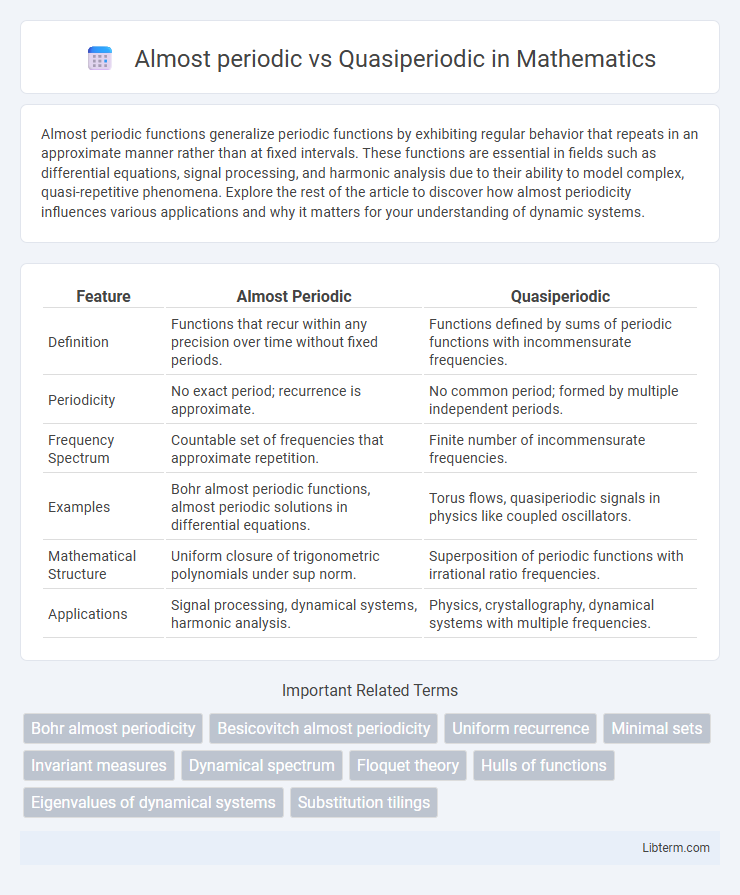Almost periodic functions generalize periodic functions by exhibiting regular behavior that repeats in an approximate manner rather than at fixed intervals. These functions are essential in fields such as differential equations, signal processing, and harmonic analysis due to their ability to model complex, quasi-repetitive phenomena. Explore the rest of the article to discover how almost periodicity influences various applications and why it matters for your understanding of dynamic systems.
Table of Comparison
| Feature | Almost Periodic | Quasiperiodic |
|---|---|---|
| Definition | Functions that recur within any precision over time without fixed periods. | Functions defined by sums of periodic functions with incommensurate frequencies. |
| Periodicity | No exact period; recurrence is approximate. | No common period; formed by multiple independent periods. |
| Frequency Spectrum | Countable set of frequencies that approximate repetition. | Finite number of incommensurate frequencies. |
| Examples | Bohr almost periodic functions, almost periodic solutions in differential equations. | Torus flows, quasiperiodic signals in physics like coupled oscillators. |
| Mathematical Structure | Uniform closure of trigonometric polynomials under sup norm. | Superposition of periodic functions with irrational ratio frequencies. |
| Applications | Signal processing, dynamical systems, harmonic analysis. | Physics, crystallography, dynamical systems with multiple frequencies. |
Introduction to Periodic Behaviors
Almost periodic functions exhibit recurring patterns that approximate periodicity with variable intervals and amplitudes, allowing for complex oscillations across time. Quasiperiodic functions combine two or more incommensurate frequencies, resulting in non-repeating but structured waveforms without a fundamental period. Both concepts extend the classical notion of periodic behavior, modeling systems with intricate temporal dynamics beyond simple repetition.
Defining Almost Periodic Functions
Almost periodic functions generalize periodic functions by allowing functions to approximate their values arbitrarily closely at irregular intervals rather than repeating exactly after a fixed period. These functions maintain a form of uniform recurrence, where for any given tolerance, there exists a relatively dense set of "almost periods" producing near-repetitions in the function's values. Quasiperiodic functions consist of superpositions of several incommensurate frequencies, creating non-repetitive but structured patterns, distinguishing them from the more flexible recurrence characteristic of almost periodic functions.
Understanding Quasiperiodic Patterns
Quasiperiodic patterns exhibit frequencies that are incommensurate, meaning their ratios are irrational and do not repeat exactly, unlike almost periodic patterns which contain frequencies that approximate periodicity closely but may not be strictly periodic. Understanding quasiperiodic systems involves analyzing their spectral properties, with discrete but dense sets of frequencies generating complex, non-repeating spatial or temporal patterns found in quasicrystals and certain dynamical systems. These patterns provide insights into non-crystallographic symmetries and the mathematical structure of aperiodic order.
Mathematical Foundations of Almost Periodicity
Almost periodic functions generalize periodic functions by allowing frequencies to vary while maintaining uniform approximations over the real line, based on Bohr's theory emphasizing uniform convergence and invariant means. Quasiperiodic functions arise from finite sums of periodic components with incommensurate frequencies, leading to patterns that never exactly repeat but exhibit structured spectral properties. The mathematical foundations of almost periodicity rely on harmonic analysis, uniform topology, and the concept of e-almost periods, distinguishing them from quasiperiodic functions through their rigorous uniform approximation criteria and invariant mean structures.
Key Characteristics of Quasiperiodicity
Quasiperiodicity is characterized by oscillations that combine multiple incommensurate frequencies, resulting in patterns that never exactly repeat but maintain a structured order. Unlike almost periodic functions, which recur with arbitrary precision over time, quasiperiodic signals exhibit continuous spectra with discrete frequency components that are linear combinations of fundamental frequencies. This property enables quasiperiodic systems to model complex phenomena in physics, such as quasicrystals and certain wave motions, where spatial or temporal structure is ordered yet non-repetitive.
Differences Between Almost Periodic and Quasiperiodic
Almost periodic functions exhibit recurring patterns with varying intervals but maintain bounded oscillations, whereas quasiperiodic functions combine multiple incommensurate frequencies leading to non-repeating, complex oscillations. The key difference lies in almost periodicity allowing for approximate repetition over time, while quasiperiodicity strictly involves sums of periodic components whose ratios are irrational. This distinction impacts their applications in signal processing and dynamical systems, where predictability and spectral properties vary significantly.
Real-World Examples of Almost Periodic Systems
Almost periodic systems frequently appear in climatology, where temperature patterns exhibit recurring but non-strict cycles influenced by complex atmospheric conditions. Human circadian rhythms demonstrate almost periodic behavior, maintaining a generally consistent cycle despite slight environmental or biological variations. In engineering, vibration signals from rotating machinery often show almost periodic characteristics due to repeated mechanical motions with small irregularities.
Applications of Quasiperiodic Structures
Quasiperiodic structures are widely utilized in photonic crystals to achieve unique light manipulation properties not possible with purely periodic materials. Their aperiodic order enables the creation of novel bandgap effects, improving optical filters, sensors, and waveguides in telecommunications and integrated optics. These applications leverage the complex spatial arrangements to optimize performance in devices requiring precise control over electromagnetic wave propagation.
Challenges in Analyzing Non-periodic Behavior
Analyzing almost periodic and quasiperiodic functions presents challenges due to their non-periodic behavior that lacks a fixed fundamental period, complicating Fourier analysis and spectral decomposition. Almost periodic functions exhibit recurrent patterns with frequencies forming a relatively dense set, while quasiperiodic functions combine incommensurate frequencies leading to non-repeating trajectories in phase space. These complexities hinder conventional time-frequency analysis and demand advanced mathematical tools such as Bohr-Fourier series for almost periodicity and ergodic theory for quasiperiodicity.
Conclusion: Choosing the Right Model
Selecting between almost periodic and quasiperiodic models depends on the system's inherent frequency components and long-term behavior. Almost periodic models effectively capture functions with recurring patterns that lack strict periodicity but exhibit uniform recurrence, while quasiperiodic models are suited for systems with frequencies that combine incommensurably, producing complex, non-repeating oscillations. Understanding the spectral characteristics and application context ensures accurate representation and prediction in fields like signal processing and dynamical systems.
Almost periodic Infographic

 libterm.com
libterm.com